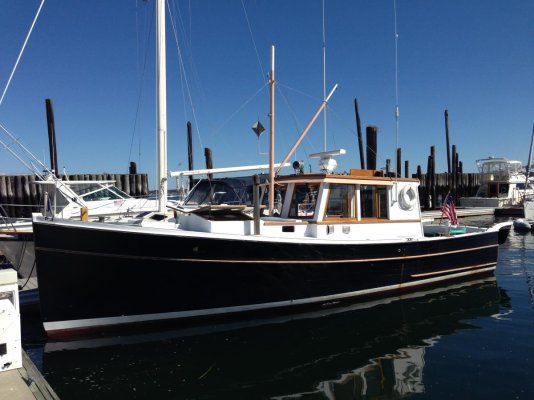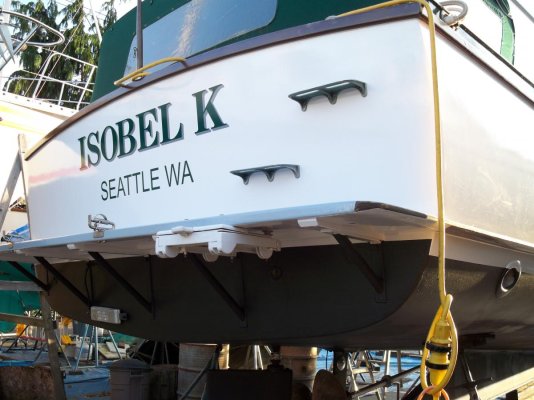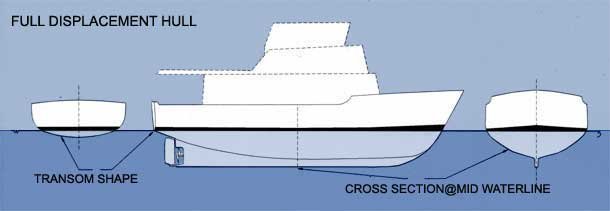Hi Eric,
Actually, my boat is not SD - I think you actually blessed it once as a displacement(true) hull in a different thread.
see if these pics help. I don't really have a shot of the whole underwater area.
Between your assessment and the fact that the boat simply will not go faster than 8.5 knots, plus she just really feels more comfortable in nasty weather, seems to point to a displacement verdict.
The rounded bilge just means any waves on the beam make for alot of rockin'.
bshanafelt,
I see your'e from Seattle. We should meet at a Starbucks sometime and go over this hull type stuff. You're obviously quite interested.
I can see from the weak reflection off the bottom of your hull the hull shape fairly accurately. The best yardstick to measure the FD-SD relationship is in the flatness of the bottom aft. Flat bottoms are planing types. And yours is nearly flat. Observe the point where the hull meets the keel fwd in your picture (lower). It appears the line that would run aft along the keel to the transom would not be flat or straight. It rises some small amount. Lets call this the keel line. If the keel line was straight you would have a planing hull whatever the shape of the chines. With one exception. If your chine turned inbd to meet on the CL of the hull like a dory the hull would be FD .. or SD if the if the chines didn't actually meet. Then there would be a transom and the hull would be SD.
Back to the keel line. If the keel line was convex and terminated at the water line at the transom the hull would be a FD type. Or even if the keel line (well aft) was straight if the transom is out of the water. There is a line that is used by NAs that's a bit better than the keel line and that's the QBBL ... quarter beam buttock line. The QBBL functions like the keel line (that I made up) but it's more comprehensive in that it takes into consideration most or all of the aft end of the bottom of the boat. The line sits at 1/4 of the beam .. hence the name of the line. If your chine line is horizontal and your keel line is 12 drgrees the QBBL would be 6 degrees. The QBBL is along the bottom of the aft end of the hull and is half way between the keel and the chine. This line basically represents the angle or slope of the bottom midships aft or an average thereof. There is an angle expressed in degrees that is a rule of thumb that is the break-off point between full disp hulls and faster types. I don't know what that angle is in degrees but I saw it expressed and used on BoatDesign.net.
I once thought if given enough power (and most all boats have) that the hull speed was reached when the bow started to rise. Not so I learned later. The bow rises considerably before HS is reached.
The yardstick I've used for most of my life is just to observe if the transom is partly submerged in the water at rest. Generally this works and no understanding of the QBBL is necessary to make the call on most any boat in the harbor. BUT ... there are exceptions. You can't make the DS/FD call on fly stuff. If only an inch of transom is submerged it's just not enough to alter the type of hull. And there are heavy FD boats that have several inches of transom submerged. BUT they all have very steep QBB lines.
So the best yardstick is the QBBL that describes the angle or slope of the bottom aft. But by either yardstick bshanafelt your lobster boat is not even close to a FD type.
In the dark shadows of your lower pic where the keel line can't be seen it is possible you have a slight hook in the bottom. That would prevent much speed as the stern would lift going fast (er) and drive the bow down. The bottom wouldn't get the angle of attack it needs to go much over hull speed and the wetted surface would be very high especially w those beautiful very soft chines. But if the keel line and QBBL are straight none of the above paragraph applies.
I do remember making a comment about your hull and changing my opinion of it but can't recall more. If I was to see the boat or better pics of the hull I may change my opinion again. Coffee?











